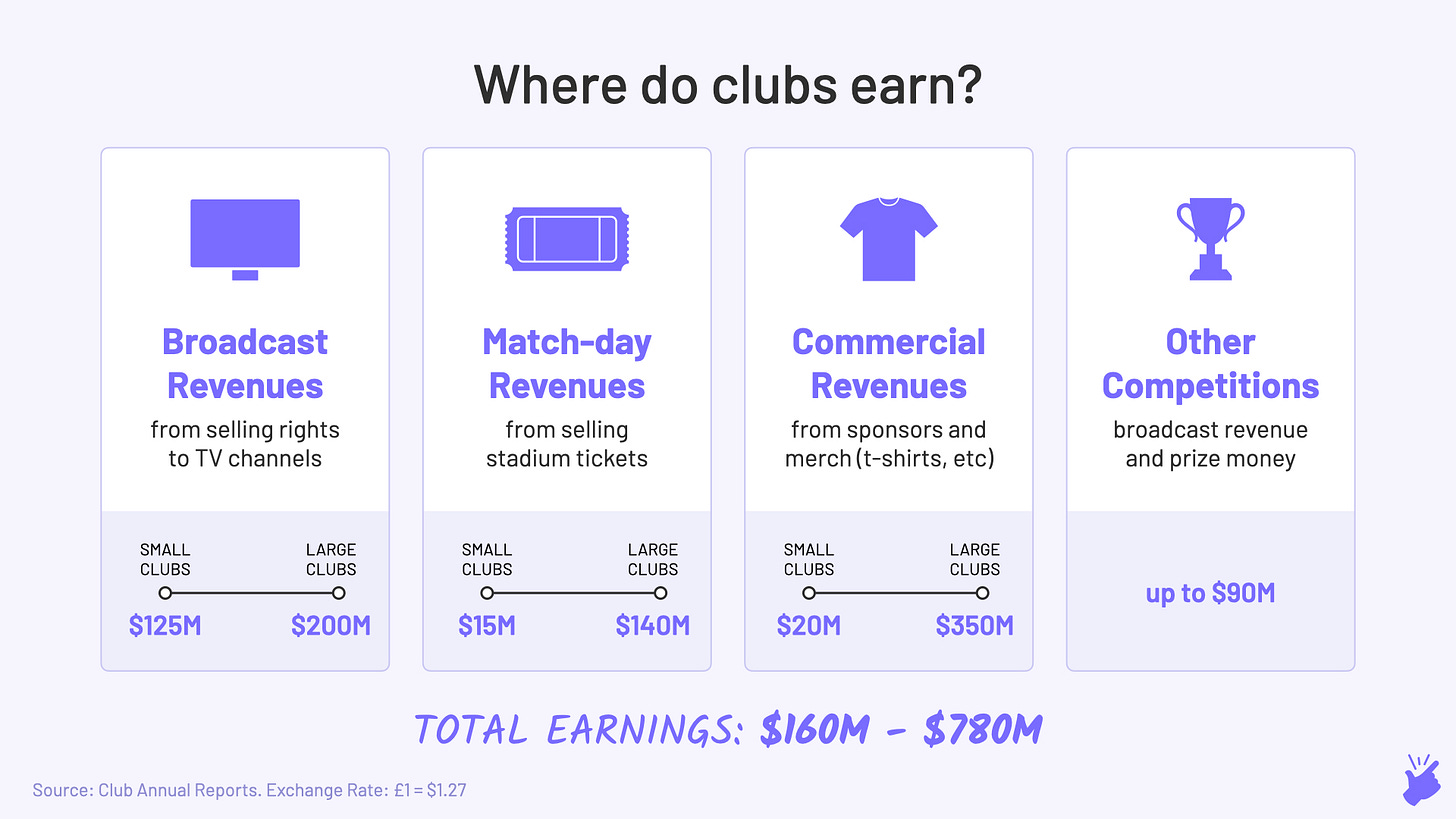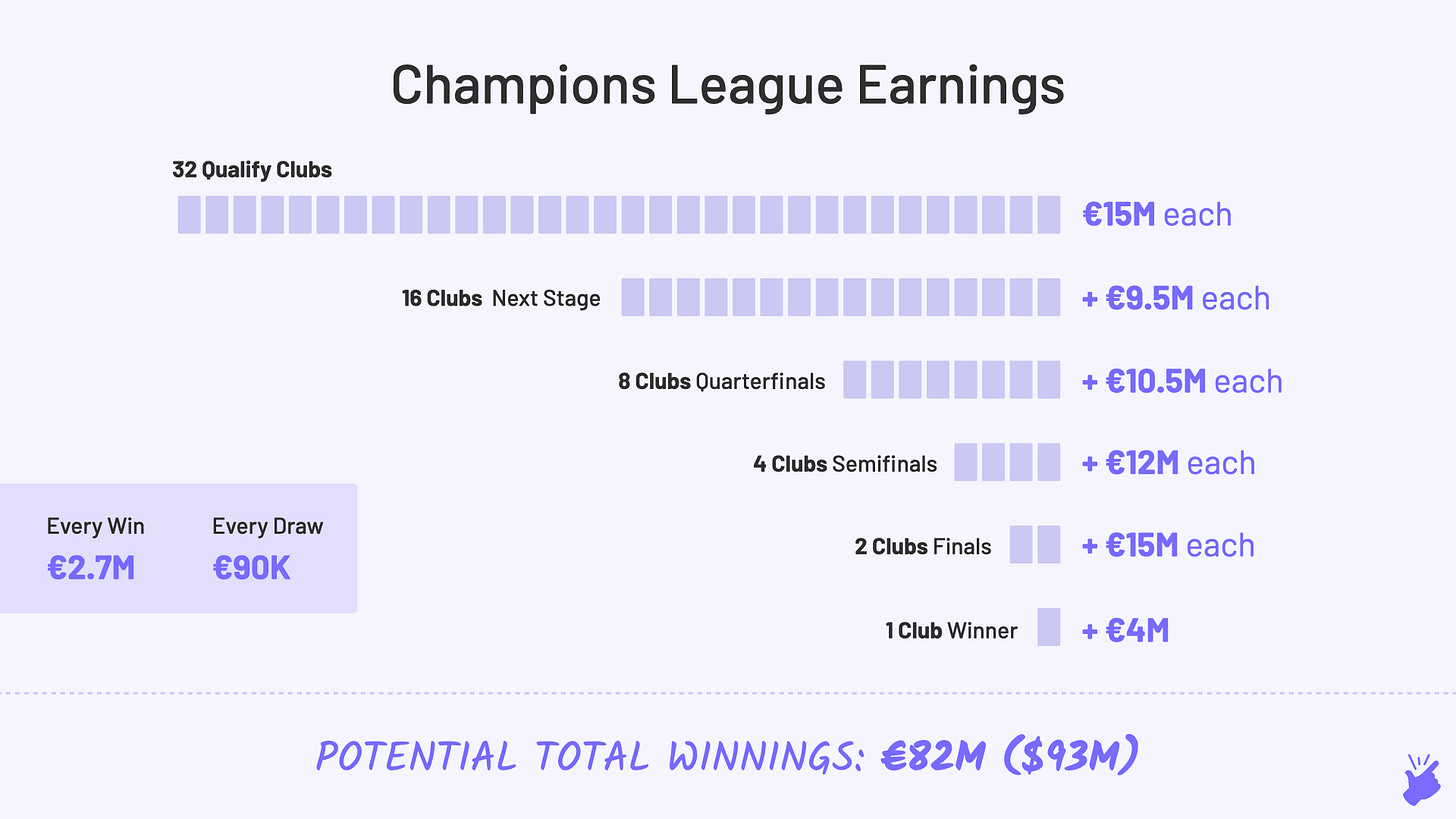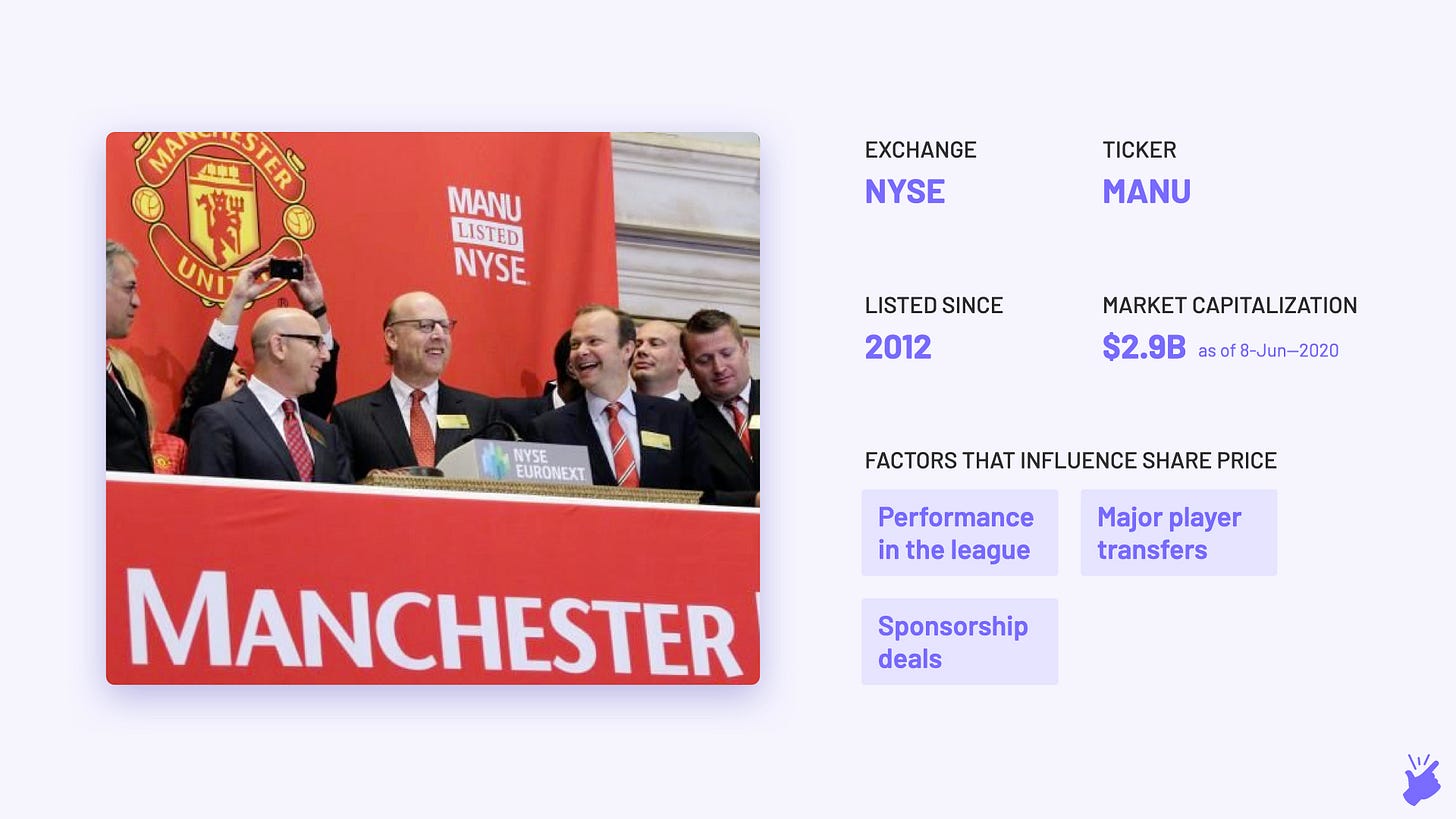#4 The Business of a Football Club - 101
Read Time: 8 minutes
Author's Note
1. For those who are not very interested in football, worry not. I have skipped explaining the offside rule and focused only on the business side !!
2. For Premier League fans, don't get too nostalgic reading this article. Matches are starting again from 17th June 🙂
3. To clarify for our American readers - I am talking about Soccer :P
"Some people think football is a matter of life and death. I assure you it's much more serious than that"
The above lines by Bill Shankly, one of the most successful managers of Liverpool Football Club sums up the craze of football pretty well. The English Premier League (EPL) is probably the most-watched sports league in the world reaching 643 million homes. With 20 clubs competing across the year to get the maximum points in the league, it is a perfect mix of skills, emotions, rivalry and drama. But behind the scenes, running a football club is a business. And every business must make money unless you are funded by Softbank 😉. So, let's understand how an EPL club operates as a business.
Like any business, we will understand them from the simple framework of 'where they spend money' and 'where do they earn it back'
Where do they spend?
Running a football club costs a bomb. Clubs spend millions of pounds on signing the best players, paying the wages of players and support staff, stadium rent and maintenance costs and other operating expenses. To understand the magnitude of these costs, let's go through them one by one. Also, since the spend varies depending on the size of the club, we would pick one large club and another relatively smaller club to compare the spends.
1. Transfer Spending
Every year, clubs try to buy the best players. And at the same time, they sell the players who are either underperformers or for whom they get a very good price offer from another club.
This trading of players does not happen throughout the year but during two specific slots in the calendar ("Transfer Windows"). One window before the start of the season (Summer window open for 2.5 months) and another mid-season (open for 1 month).
In most cases, clubs are net spenders in these transfer windows (Net Spend = Money spent on buying players - Money received by selling players). In last year's summer window, all the EPL clubs together spent a net £1.4B ($1.8B) on buying new players from across the globe (that was the size of the Punjab National Bank/Nirav Modi fraud by the way).
On an individual basis, a large club like Manchester United's net spend was £74M ($94M) last year while a smaller club like Bournemouth FC's was 1/8th of that at £9M ($11M).
In very few instances, a club can actually be a net earner. Last year, Liverpool and Crytal Palace spent less than what they earned from selling players. But this is very rare and in most cases, transfer spending remains a cost for football clubs.
2. Player & Support Staff Wages
Premier League footballers are few of the highest-paid athletes in the world. At present, De Gea is the highest-paid player in EPL with an annual salary of £20M ($25M).
With many star players in the squad, a large club like Manchester United paid out £150M ($190M) in player wages last year. And a smaller club like Bournemouth FC paid £47M ($60M).
Apart from players, the wage bill for the club manager, support staff, medics, stadium staff comes out to be in the range of £10-40M ($12-50M) depending on the size of the club.
3. Other Operating Expenses
Apart from wages, there are a lot of other expenses that clubs need to bear on a continuous basis to keep the business running ("operations"). Major ones being
Stadium & Facility Maintenance
Few clubs rent out stadiums while few others own stadiums (so no rent). Sometimes, clubs might choose to build new stadiums which will result in extra expenses. For example, Chelsea is building a new stadium which is going to cost them around £1B ($1.3B)Youth Academies
Clubs also invest in youth academies where future talent is identified and developed.Marketing & Admin
They also (need to) spend on marketing campaigns (mailers, ads & events), IT systems (website, apps, ticketing systems, etc) and accounting.Travel
Lastly, since the players are always on the road for matches, travel expenses can add up to be a major expense for clubs.
Overall, large clubs spend around £70M ($90M) in operating expenses while smaller clubs spend around £20M ($25M).
Where do they earn?
1. Broadcasting Revenues
Selling the rights to broadcast matches to TV channels is the biggest source of revenue. But this doesn't happen at a club level. The revenue is earned at the league level and then split between the clubs. Here's how revenue is shared.
Usually, domestic rights are sold to TV channels for a 3 year period. For 2016-19, the rights were sold to Sky Sports and BT Sport for £5.1B ($6.5B). This translates to roughly £1.7B ($2.1B) per year. Besides domestic rights, overseas broadcasting rights were sold for £0.9B (overseas rights are sold on a yearly basis).
The revenue from domestic and overseas rights is split among clubs in different ways.
Overseas rights: Split equally among clubs
In 2019, each club received £43M [£0.9B divided by 20 clubs]Domestic rights: Divided 3 ways among clubs
A) 50% is equally split among all clubs
For each of the last 3 years, each club received £43M [(50% of £1.7B) ÷ 20 clubs]B) 25% is paid as 'merit money'
The merit of a club is decided based on the final ranking of the club at the end of the season. The team at the bottom (20th rank) gets £2M [(25% of £1.7B) ÷ (1+2+....+19+20)]. And you get an additional £2M for every position as you move up the ranking table (19th rank gets £4M and so on). Last year's winner, Manchester City, took home £40M ($50M)C) 25% is paid as 'facility fees'
A 'facility fee' is paid based on how many times a club's matches are aired on TV.The facility fee is divided into fixed and variable components for every club. Last year, every club was guaranteed a fixed £12M ($15M) for 10 or less games aired live. Beyond 10 games, the club received additional £1M ($1.3M) for every game.
Liverpool, which had the highest number of games aired (29 matched) made £33M ($42M) in facility fees. Huddersfield Town, which had just 10 games aired live, made only the fixed £12M ($15M).
Wait, not all EPL matches are aired live?
Yes, not all are aired live and it's because of a scheduling quirk. Since EPL matches happen only on weekends, there can be 4 to 12 games scheduled at the same time, say 5pm on Saturday. But the TV channels can show only 2 matches live at any given time. Here too, larger and more popular clubs have an advantage. It's because broadcasters select which 2 matches will be aired. Naturally, they'll select those club matches which will attract a larger audience (so they can earn more advertising revenue).
2. Match Day Revenues
While millions watch the game on TV, thousands watch the game at stadiums. Clubs play 19 games at their home stadiums. And they make money during these matches from ticket sales, food and drinks.
Higher the ticket prices, higher the match-day revenues.
London based clubs (Arsenal, Chelsea, West Ham & Tottenham) generally have higher ticket prices (£75-95) while others charge anywhere between £40-60.
Higher the stadium capacity, higher the match-day revenues.
For this reason, a lot of clubs (Chelsea and Tottenham in recent times) try to shift to larger stadiums.
Last year, Manchester United made the highest match-day revenues at £111M ($140M). A relatively smaller Crystal Palace made only £11M ($14M)
3. Commercial Revenues
This stream accounts for the highest contribution to the clubs' revenues. Generally, this income is divided into sponsorship and merchandising.
Sponsorship
With millions of fans watching these games, hundreds of brands try to partner the clubs as sponsors. For example, Adidas pays £75M ($95M) per year to be Manchester United's kit (uniform) sponsors. And Chevrolet pays £65M ($82M) per year to be their premier sponsors. Apart from these two, Manchester United has 24 other sponsors.
Merchandising
As part of this, clubs sell jerseys, sports accessories, branded gifts through both their websites and club stores. Manchester United nets around £100M ($127M) from merchandise sale every year.
Last year, Manchester United netted a total of £276M ($350M) in total commercial income. In comparison, a smaller club like Crystal Palace made a paltry £15M ($19M).
4. Money from Other Competitions
Every year, the top 4 clubs from EPL (in most cases) qualify for the biggest competition in European Football: Champions League. Top clubs from different European leagues (English, Spanish, Italian, etc) compete against each other for eternal glory money.
Just like EPL, clubs get a share of the broadcast revenues and merit money basis their ranking (see pic below). Apart from these, the teams also get €2.7M ($3M) for every match they win and €90k ($100K) for every match they draw (too much money, right?).
Considering a team wins all the matches and goes on to lift the cup, it can take home €82M ($93M).
Apart from Champions leagues, clubs also earn from another competition 'Europa league' though the earnings there are relatively small.
Who (really) won the cup?
In the 2019-20 season, even though Liverpool was at the top of the table (no clear winner because Covid-19 left the season incomplete), it was Manchester United that ended with the highest revenue (£627M or $800M) in EPL owing to its high commercial revenue. It was also the most profitable club with an operating profit of £185M (revenue minus core expenses only & before interest, depreciation, and taxes).
One more thing...
Did you know you could invest in these clubs?
Like any other business, clubs can also be listed on stock exchanges where the general public (you & me) can invest. Manchester United is actually listed on the New York Stock Exchange since 2012.
Ciao!
That's it for today. If you liked the article, do share it with your friends who are football fans 🙂
If you liked this Simplanation, share it your friends !!
More reads on the topic...
Deloitte Football Money League | Deloitte UK
Deloitte releases this interesting report on football revenues every yearSwissRamble
One of the best Twitter accounts with regular updates on premier league clubs' financesPremier League finances: the full club-by-club breakdown and verdict
A complete break-up of the revenues and expenses of all EPL clubs from the year 2017-18










Who decides the salaries of the players? are they also paid entirely on rankings?
Can we get a similar simplanation on IPL?